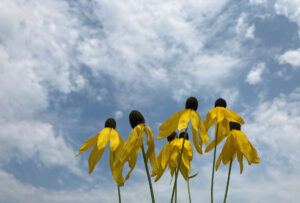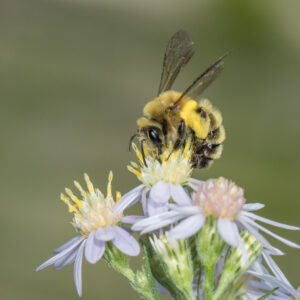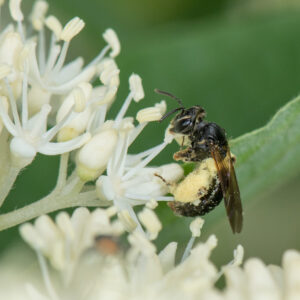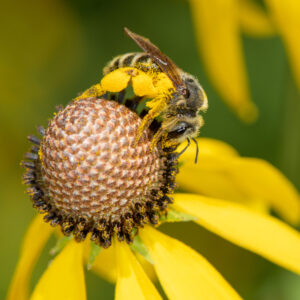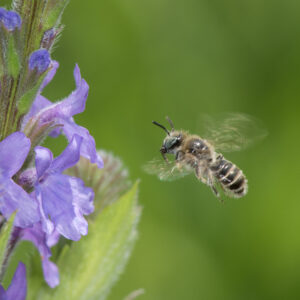This article was written by Heather Holm, photos also provided by Heather Holm. Learn more about Heather and her work here.
While the most famous insect specialist that visits our gardens is the monarch butterfly (Danaus plexippus), as many as 25% of native bee species in a particular region in the United States are specialists. That is an astounding figure given we have approximately 3700 species of native bees in the United States and Canada. If our landscapes were devoid of native plants, we would be failing to provide the critical nourishment that these specialists need to complete their life’s work—rear the next generation of bees. The monarch butterfly is a fairly strict specialist, the larvae (caterpillars) feed only on specific host plants belonging to the genus Asclepias (milkweed). Similarly, native specialist bees also have native host plants. Specialization can range from narrow to broad. For example, monolectic bees specialize on a single plant species, while narrow oligolectic bees specialize on plants belonging to one plant genus, and oligolectic bees on a few related plant genera. In many instances, these specializations can be mutually beneficial for the bee and the host plant: improved pollination for the plant and an increase in the abundance of host plants for the bee.
Bees are essentially hairy, vegetarian wasps. Their carnivorous, predatory wasp cousins feed their larvae insects or spiders. The radiation of flowering plants (angiosperms) during the Cretaceous period and the alternative food source that these pollen- and nectar-rich plants provided, is one reason bees likely evolved or diverged from their wasp cousins to have an entirely plant-based diet. Bees are also equipped with numerous branched hairs that enable females to efficiently transport loads of pollen back to their nests. While adult females consume pollen for nourishment and protein, the larvae are the primary consumer of the specialized or specific pollen diet. Specializing on collecting only pollen from one plant genus can be risky, particularly with the projected changes resulting from the climate warming—plants may flower earlier or later than historical averages, or have a shorter flowering period. The result is a very precarious situation for specialist bees that are already at risk of becoming extirpated from the highly fragmented or degraded habitats where they live. Climate change in many instances may cause the mismatch or unpairing of the emergence of the specialist bees and the flowering phenology of the plants they depend upon.
There are simple things gardeners can do to help, however. In addition to remnant and restored natural landscapes, common (and uncommon) specialist bees can thrive in pesticide-free, native plant-rich urban and suburban gardens when the host plants are present. By focusing on some specific plant families and genera, we can maximize the number of native bee specialist host plants. The plant family Asteraceae is by far the heavy hitter, supporting the most species of specialists in all regions of the United States. Summer- and autumn-blooming perennial plants in this family such as black-eyed Susan (Rudbeckia), sunflower (Helianthus), goldenrod (Solidago, Euthamia, Oligoneuron), and aster (Symphyotrichum, Eurybia) are already standard plants in native plant gardens and restorations. Perennials are not the only host plants of native bee specialists. A number of native woody shrubs also support specialists. Willow (Salix), already considered a keystone plant for the number of lepidopteran larvae (butterfly and moth caterpillars) it hosts, also provides pollen for one to two dozen (or more) specialist bees depending on the region. Dogwood (Cornus), another common garden plant, also supports several monolectic specialists. After planting a few species of dogwoods in my garden, the following growing season I documented one of the monolectic dogwood specialists visiting the flowers—the short-haired dogwood mining bee (Andrena integra). One of the most fascinating native bee host plant is native loosestrife (Lysimachia). The flowers are nectarless and in addition to producing pollen, glands on the flower petals and filaments produce floral oil. The pollen and the oil is simultaneously collected by oil-collecting, ground-nesting bees in the genus Macropis. Females have specialized brushes on their forelegs for combing the oil and, while doing so, use their other legs to brush the pollen. The oil is used for two purposes: for food combined with the pollen and for a nest waterproofing material.
To learn more about what native plants support specialists bees in your region, please refer to the comprehensive regional listings compiled by Jarrod Fowler at: http://jarrodfowler.com/specialist_bees.html
Some additional things to do to support specialist bees is advocate for the preservation and restoration of rare native plant communities, plant more native bee host plants in your garden, keep the garden pesticide-free, and ask local native plant growers to grow more regionally-appropriate native bee host plants. Remember, if you plant it, they will come!

